Tourism Consumer Behaviour and Insight: A Comprehensive Analysis
VerifiedAdded on 2022/12/27
|13
|4240
|46
Report
AI Summary
This report provides a comprehensive analysis of tourism consumer behavior, examining the cultural, social, personal, and psychological factors that influence consumer decisions within the tourism sector, with a specific focus on the UK's national tourism agency, VisitBritain. The report investigates how digital technology is reshaping consumer trends and behaviors, offering insights into market research and product comparison. It details the stages of the consumer decision-making journey, mapping a path to purchase for VisitBritain, and explores the importance of understanding this process for marketers. Furthermore, it compares and contrasts the B2C and B2B decision-making processes within the hospitality sector, providing specific tourism examples and evaluating different market research approaches used to understand consumer behavior. The report also assesses how marketers can influence the various stages of the tourism decision-making process, offering actionable strategies and examples to enhance marketing effectiveness and customer engagement. The content is contributed by a student and available on Desklib, a platform providing AI-based study tools.
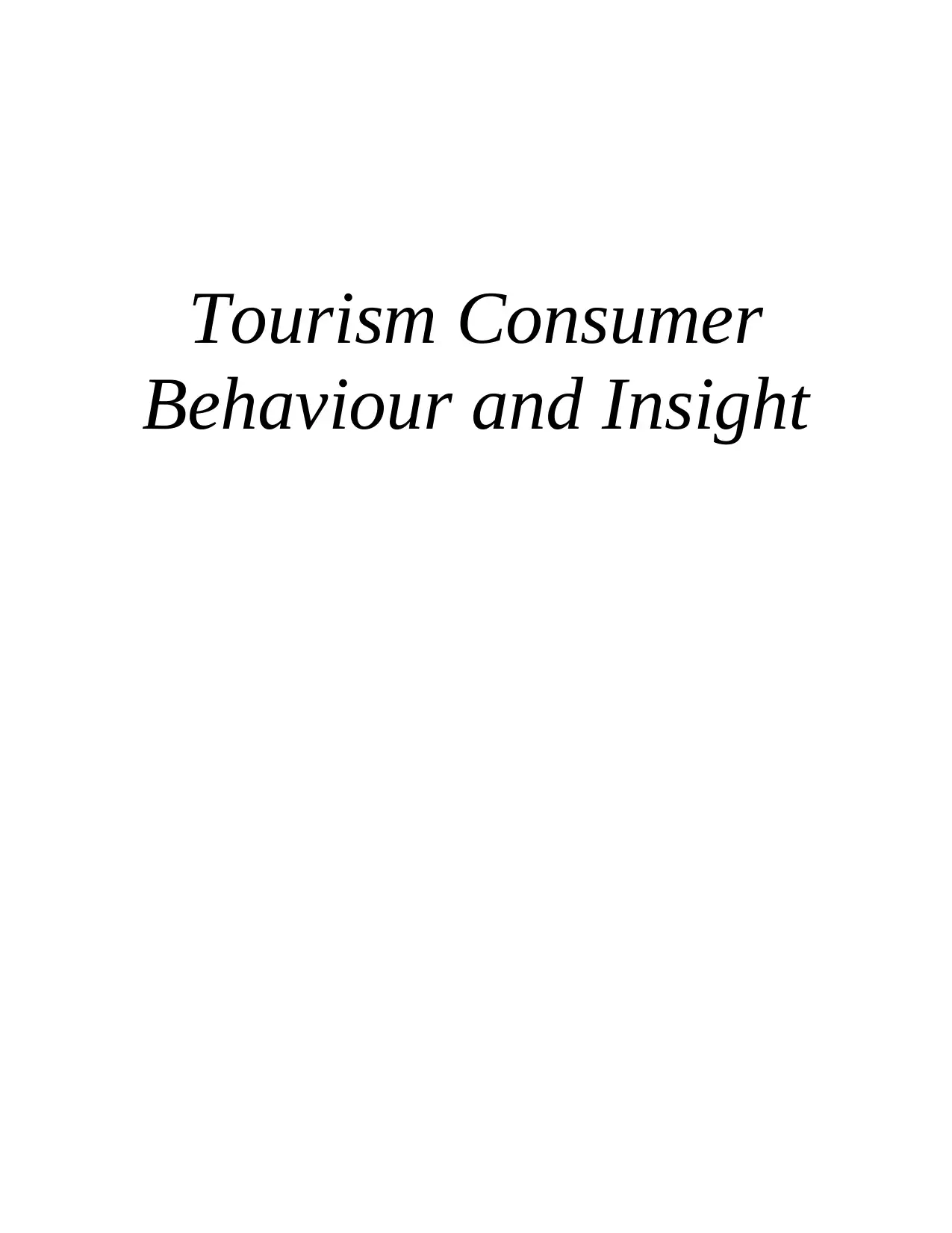
Tourism Consumer
Behaviour and Insight
Behaviour and Insight
Paraphrase This Document
Need a fresh take? Get an instant paraphrase of this document with our AI Paraphraser
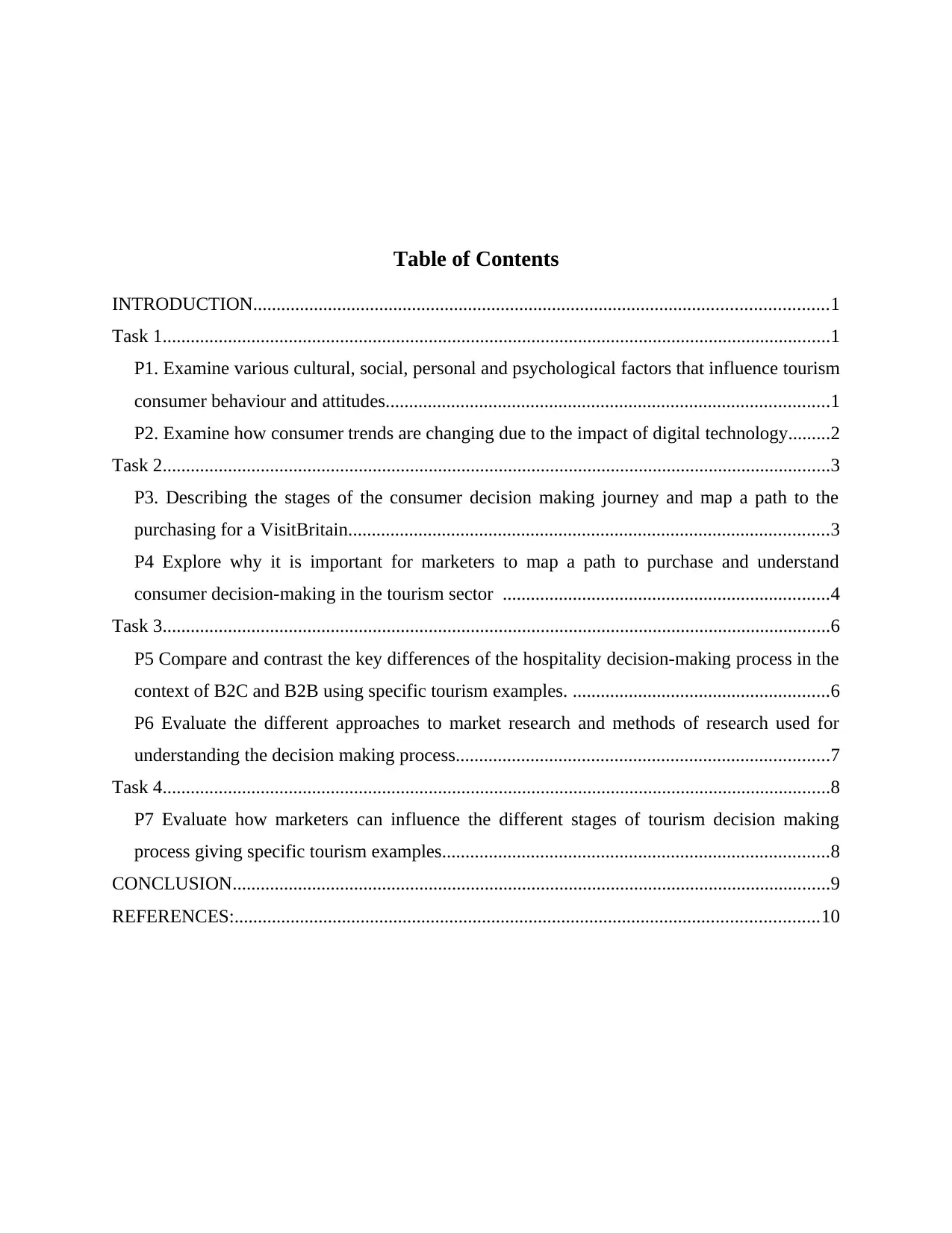
Table of Contents
INTRODUCTION...........................................................................................................................1
Task 1...............................................................................................................................................1
P1. Examine various cultural, social, personal and psychological factors that influence tourism
consumer behaviour and attitudes...............................................................................................1
P2. Examine how consumer trends are changing due to the impact of digital technology.........2
Task 2...............................................................................................................................................3
P3. Describing the stages of the consumer decision making journey and map a path to the
purchasing for a VisitBritain.......................................................................................................3
P4 Explore why it is important for marketers to map a path to purchase and understand
consumer decision-making in the tourism sector ......................................................................4
Task 3...............................................................................................................................................6
P5 Compare and contrast the key differences of the hospitality decision-making process in the
context of B2C and B2B using specific tourism examples. .......................................................6
P6 Evaluate the different approaches to market research and methods of research used for
understanding the decision making process................................................................................7
Task 4...............................................................................................................................................8
P7 Evaluate how marketers can influence the different stages of tourism decision making
process giving specific tourism examples...................................................................................8
CONCLUSION................................................................................................................................9
REFERENCES:.............................................................................................................................10
INTRODUCTION...........................................................................................................................1
Task 1...............................................................................................................................................1
P1. Examine various cultural, social, personal and psychological factors that influence tourism
consumer behaviour and attitudes...............................................................................................1
P2. Examine how consumer trends are changing due to the impact of digital technology.........2
Task 2...............................................................................................................................................3
P3. Describing the stages of the consumer decision making journey and map a path to the
purchasing for a VisitBritain.......................................................................................................3
P4 Explore why it is important for marketers to map a path to purchase and understand
consumer decision-making in the tourism sector ......................................................................4
Task 3...............................................................................................................................................6
P5 Compare and contrast the key differences of the hospitality decision-making process in the
context of B2C and B2B using specific tourism examples. .......................................................6
P6 Evaluate the different approaches to market research and methods of research used for
understanding the decision making process................................................................................7
Task 4...............................................................................................................................................8
P7 Evaluate how marketers can influence the different stages of tourism decision making
process giving specific tourism examples...................................................................................8
CONCLUSION................................................................................................................................9
REFERENCES:.............................................................................................................................10
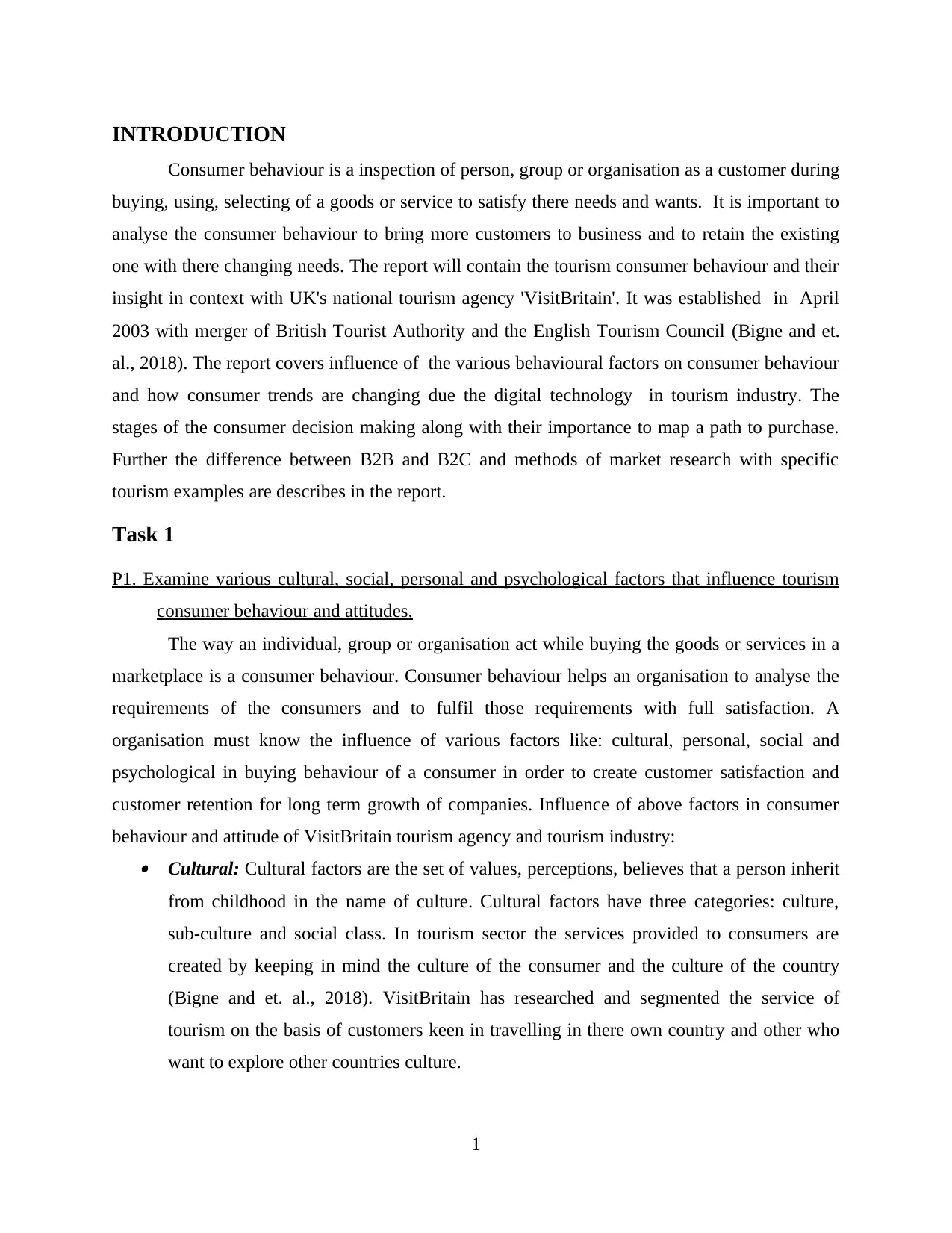
INTRODUCTION
Consumer behaviour is a inspection of person, group or organisation as a customer during
buying, using, selecting of a goods or service to satisfy there needs and wants. It is important to
analyse the consumer behaviour to bring more customers to business and to retain the existing
one with there changing needs. The report will contain the tourism consumer behaviour and their
insight in context with UK's national tourism agency 'VisitBritain'. It was established in April
2003 with merger of British Tourist Authority and the English Tourism Council (Bigne and et.
al., 2018). The report covers influence of the various behavioural factors on consumer behaviour
and how consumer trends are changing due the digital technology in tourism industry. The
stages of the consumer decision making along with their importance to map a path to purchase.
Further the difference between B2B and B2C and methods of market research with specific
tourism examples are describes in the report.
Task 1
P1. Examine various cultural, social, personal and psychological factors that influence tourism
consumer behaviour and attitudes.
The way an individual, group or organisation act while buying the goods or services in a
marketplace is a consumer behaviour. Consumer behaviour helps an organisation to analyse the
requirements of the consumers and to fulfil those requirements with full satisfaction. A
organisation must know the influence of various factors like: cultural, personal, social and
psychological in buying behaviour of a consumer in order to create customer satisfaction and
customer retention for long term growth of companies. Influence of above factors in consumer
behaviour and attitude of VisitBritain tourism agency and tourism industry: Cultural: Cultural factors are the set of values, perceptions, believes that a person inherit
from childhood in the name of culture. Cultural factors have three categories: culture,
sub-culture and social class. In tourism sector the services provided to consumers are
created by keeping in mind the culture of the consumer and the culture of the country
(Bigne and et. al., 2018). VisitBritain has researched and segmented the service of
tourism on the basis of customers keen in travelling in there own country and other who
want to explore other countries culture.
1
Consumer behaviour is a inspection of person, group or organisation as a customer during
buying, using, selecting of a goods or service to satisfy there needs and wants. It is important to
analyse the consumer behaviour to bring more customers to business and to retain the existing
one with there changing needs. The report will contain the tourism consumer behaviour and their
insight in context with UK's national tourism agency 'VisitBritain'. It was established in April
2003 with merger of British Tourist Authority and the English Tourism Council (Bigne and et.
al., 2018). The report covers influence of the various behavioural factors on consumer behaviour
and how consumer trends are changing due the digital technology in tourism industry. The
stages of the consumer decision making along with their importance to map a path to purchase.
Further the difference between B2B and B2C and methods of market research with specific
tourism examples are describes in the report.
Task 1
P1. Examine various cultural, social, personal and psychological factors that influence tourism
consumer behaviour and attitudes.
The way an individual, group or organisation act while buying the goods or services in a
marketplace is a consumer behaviour. Consumer behaviour helps an organisation to analyse the
requirements of the consumers and to fulfil those requirements with full satisfaction. A
organisation must know the influence of various factors like: cultural, personal, social and
psychological in buying behaviour of a consumer in order to create customer satisfaction and
customer retention for long term growth of companies. Influence of above factors in consumer
behaviour and attitude of VisitBritain tourism agency and tourism industry: Cultural: Cultural factors are the set of values, perceptions, believes that a person inherit
from childhood in the name of culture. Cultural factors have three categories: culture,
sub-culture and social class. In tourism sector the services provided to consumers are
created by keeping in mind the culture of the consumer and the culture of the country
(Bigne and et. al., 2018). VisitBritain has researched and segmented the service of
tourism on the basis of customers keen in travelling in there own country and other who
want to explore other countries culture.
1
⊘ This is a preview!⊘
Do you want full access?
Subscribe today to unlock all pages.

Trusted by 1+ million students worldwide
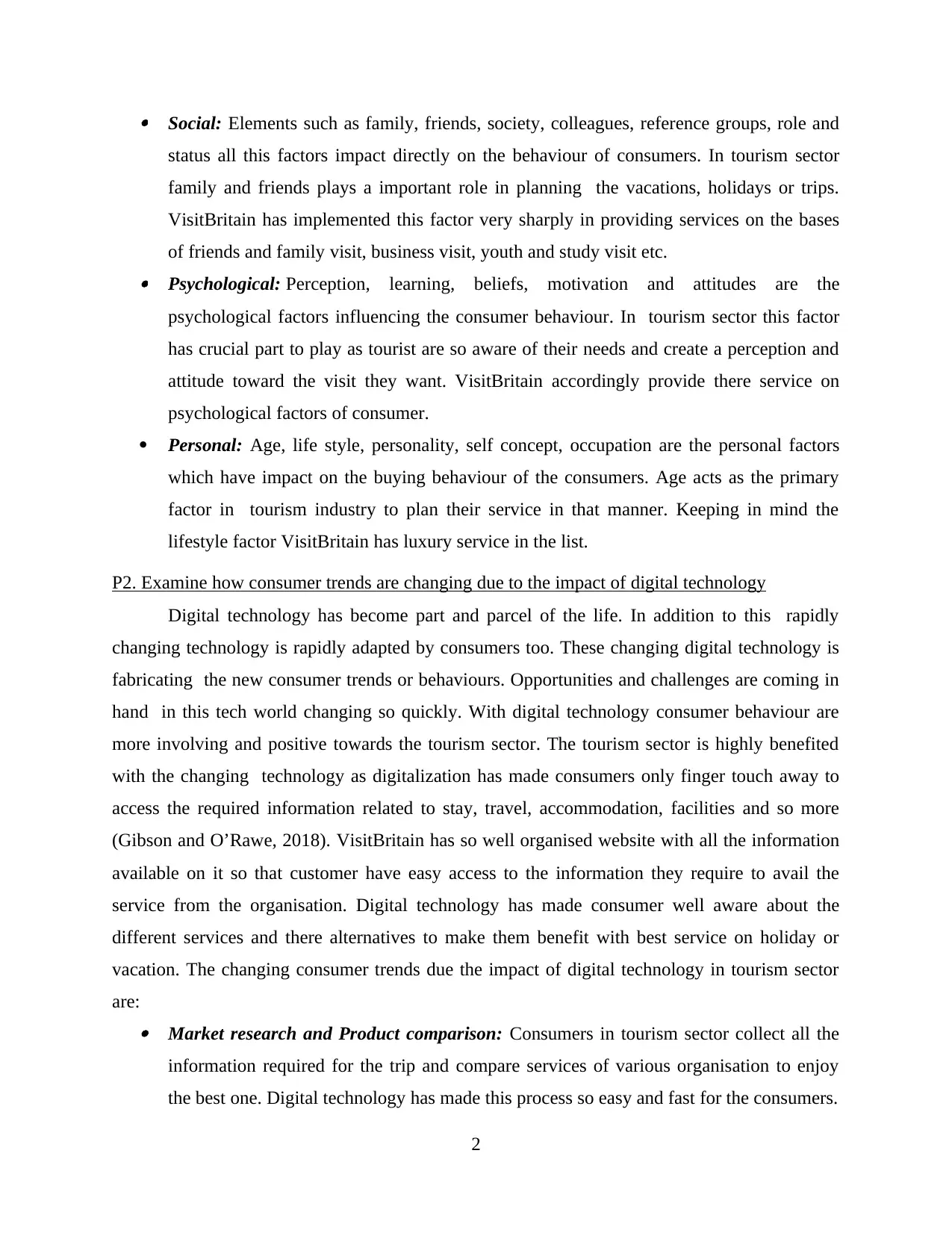
Social: Elements such as family, friends, society, colleagues, reference groups, role and
status all this factors impact directly on the behaviour of consumers. In tourism sector
family and friends plays a important role in planning the vacations, holidays or trips.
VisitBritain has implemented this factor very sharply in providing services on the bases
of friends and family visit, business visit, youth and study visit etc. Psychological: Perception, learning, beliefs, motivation and attitudes are the
psychological factors influencing the consumer behaviour. In tourism sector this factor
has crucial part to play as tourist are so aware of their needs and create a perception and
attitude toward the visit they want. VisitBritain accordingly provide there service on
psychological factors of consumer.
Personal: Age, life style, personality, self concept, occupation are the personal factors
which have impact on the buying behaviour of the consumers. Age acts as the primary
factor in tourism industry to plan their service in that manner. Keeping in mind the
lifestyle factor VisitBritain has luxury service in the list.
P2. Examine how consumer trends are changing due to the impact of digital technology
Digital technology has become part and parcel of the life. In addition to this rapidly
changing technology is rapidly adapted by consumers too. These changing digital technology is
fabricating the new consumer trends or behaviours. Opportunities and challenges are coming in
hand in this tech world changing so quickly. With digital technology consumer behaviour are
more involving and positive towards the tourism sector. The tourism sector is highly benefited
with the changing technology as digitalization has made consumers only finger touch away to
access the required information related to stay, travel, accommodation, facilities and so more
(Gibson and O’Rawe, 2018). VisitBritain has so well organised website with all the information
available on it so that customer have easy access to the information they require to avail the
service from the organisation. Digital technology has made consumer well aware about the
different services and there alternatives to make them benefit with best service on holiday or
vacation. The changing consumer trends due the impact of digital technology in tourism sector
are: Market research and Product comparison: Consumers in tourism sector collect all the
information required for the trip and compare services of various organisation to enjoy
the best one. Digital technology has made this process so easy and fast for the consumers.
2
status all this factors impact directly on the behaviour of consumers. In tourism sector
family and friends plays a important role in planning the vacations, holidays or trips.
VisitBritain has implemented this factor very sharply in providing services on the bases
of friends and family visit, business visit, youth and study visit etc. Psychological: Perception, learning, beliefs, motivation and attitudes are the
psychological factors influencing the consumer behaviour. In tourism sector this factor
has crucial part to play as tourist are so aware of their needs and create a perception and
attitude toward the visit they want. VisitBritain accordingly provide there service on
psychological factors of consumer.
Personal: Age, life style, personality, self concept, occupation are the personal factors
which have impact on the buying behaviour of the consumers. Age acts as the primary
factor in tourism industry to plan their service in that manner. Keeping in mind the
lifestyle factor VisitBritain has luxury service in the list.
P2. Examine how consumer trends are changing due to the impact of digital technology
Digital technology has become part and parcel of the life. In addition to this rapidly
changing technology is rapidly adapted by consumers too. These changing digital technology is
fabricating the new consumer trends or behaviours. Opportunities and challenges are coming in
hand in this tech world changing so quickly. With digital technology consumer behaviour are
more involving and positive towards the tourism sector. The tourism sector is highly benefited
with the changing technology as digitalization has made consumers only finger touch away to
access the required information related to stay, travel, accommodation, facilities and so more
(Gibson and O’Rawe, 2018). VisitBritain has so well organised website with all the information
available on it so that customer have easy access to the information they require to avail the
service from the organisation. Digital technology has made consumer well aware about the
different services and there alternatives to make them benefit with best service on holiday or
vacation. The changing consumer trends due the impact of digital technology in tourism sector
are: Market research and Product comparison: Consumers in tourism sector collect all the
information required for the trip and compare services of various organisation to enjoy
the best one. Digital technology has made this process so easy and fast for the consumers.
2
Paraphrase This Document
Need a fresh take? Get an instant paraphrase of this document with our AI Paraphraser
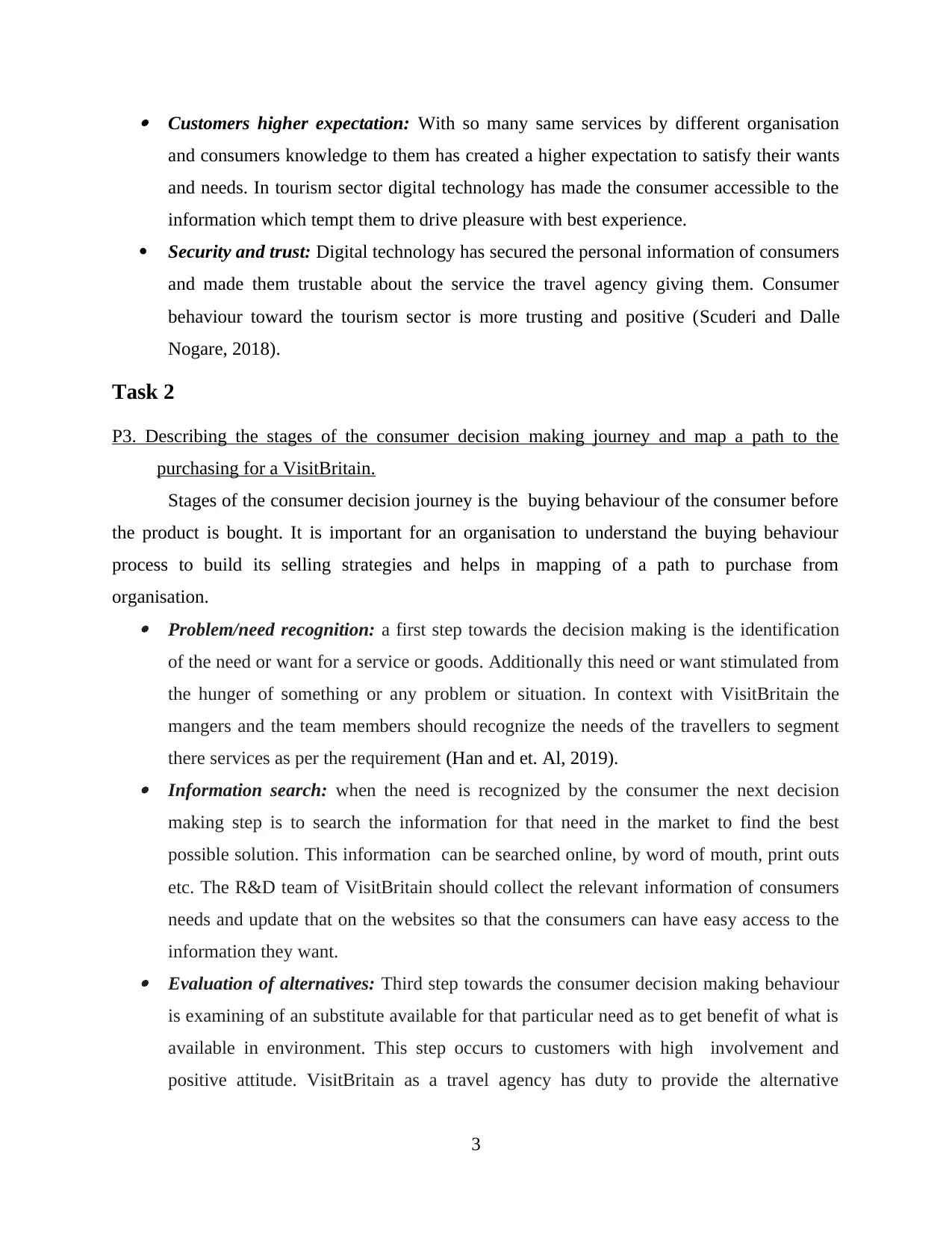
Customers higher expectation: With so many same services by different organisation
and consumers knowledge to them has created a higher expectation to satisfy their wants
and needs. In tourism sector digital technology has made the consumer accessible to the
information which tempt them to drive pleasure with best experience.
Security and trust: Digital technology has secured the personal information of consumers
and made them trustable about the service the travel agency giving them. Consumer
behaviour toward the tourism sector is more trusting and positive (Scuderi and Dalle
Nogare, 2018).
Task 2
P3. Describing the stages of the consumer decision making journey and map a path to the
purchasing for a VisitBritain.
Stages of the consumer decision journey is the buying behaviour of the consumer before
the product is bought. It is important for an organisation to understand the buying behaviour
process to build its selling strategies and helps in mapping of a path to purchase from
organisation. Problem/need recognition: a first step towards the decision making is the identification
of the need or want for a service or goods. Additionally this need or want stimulated from
the hunger of something or any problem or situation. In context with VisitBritain the
mangers and the team members should recognize the needs of the travellers to segment
there services as per the requirement (Han and et. Al, 2019). Information search: when the need is recognized by the consumer the next decision
making step is to search the information for that need in the market to find the best
possible solution. This information can be searched online, by word of mouth, print outs
etc. The R&D team of VisitBritain should collect the relevant information of consumers
needs and update that on the websites so that the consumers can have easy access to the
information they want. Evaluation of alternatives: Third step towards the consumer decision making behaviour
is examining of an substitute available for that particular need as to get benefit of what is
available in environment. This step occurs to customers with high involvement and
positive attitude. VisitBritain as a travel agency has duty to provide the alternative
3
and consumers knowledge to them has created a higher expectation to satisfy their wants
and needs. In tourism sector digital technology has made the consumer accessible to the
information which tempt them to drive pleasure with best experience.
Security and trust: Digital technology has secured the personal information of consumers
and made them trustable about the service the travel agency giving them. Consumer
behaviour toward the tourism sector is more trusting and positive (Scuderi and Dalle
Nogare, 2018).
Task 2
P3. Describing the stages of the consumer decision making journey and map a path to the
purchasing for a VisitBritain.
Stages of the consumer decision journey is the buying behaviour of the consumer before
the product is bought. It is important for an organisation to understand the buying behaviour
process to build its selling strategies and helps in mapping of a path to purchase from
organisation. Problem/need recognition: a first step towards the decision making is the identification
of the need or want for a service or goods. Additionally this need or want stimulated from
the hunger of something or any problem or situation. In context with VisitBritain the
mangers and the team members should recognize the needs of the travellers to segment
there services as per the requirement (Han and et. Al, 2019). Information search: when the need is recognized by the consumer the next decision
making step is to search the information for that need in the market to find the best
possible solution. This information can be searched online, by word of mouth, print outs
etc. The R&D team of VisitBritain should collect the relevant information of consumers
needs and update that on the websites so that the consumers can have easy access to the
information they want. Evaluation of alternatives: Third step towards the consumer decision making behaviour
is examining of an substitute available for that particular need as to get benefit of what is
available in environment. This step occurs to customers with high involvement and
positive attitude. VisitBritain as a travel agency has duty to provide the alternative
3
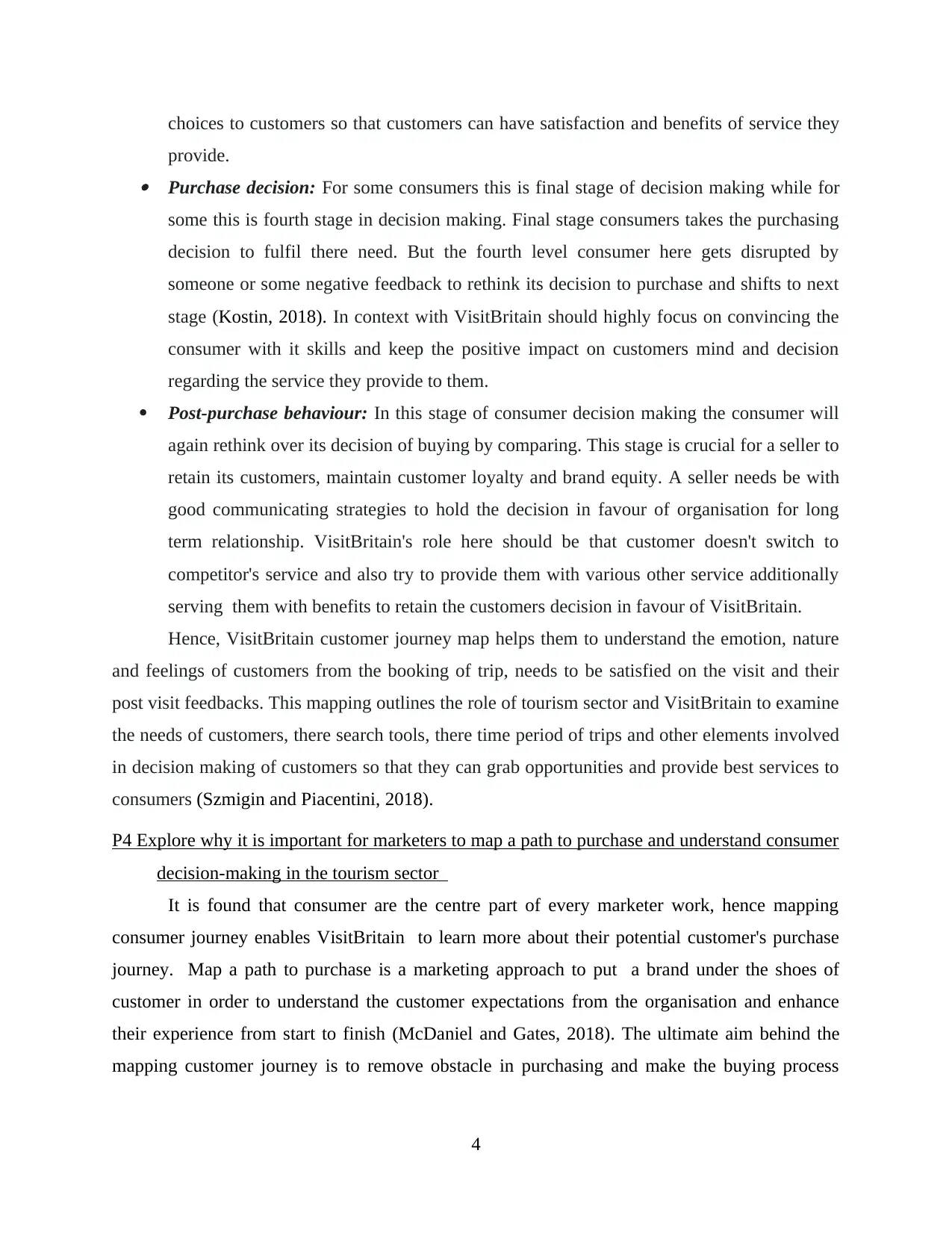
choices to customers so that customers can have satisfaction and benefits of service they
provide. Purchase decision: For some consumers this is final stage of decision making while for
some this is fourth stage in decision making. Final stage consumers takes the purchasing
decision to fulfil there need. But the fourth level consumer here gets disrupted by
someone or some negative feedback to rethink its decision to purchase and shifts to next
stage (Kostin, 2018). In context with VisitBritain should highly focus on convincing the
consumer with it skills and keep the positive impact on customers mind and decision
regarding the service they provide to them.
Post-purchase behaviour: In this stage of consumer decision making the consumer will
again rethink over its decision of buying by comparing. This stage is crucial for a seller to
retain its customers, maintain customer loyalty and brand equity. A seller needs be with
good communicating strategies to hold the decision in favour of organisation for long
term relationship. VisitBritain's role here should be that customer doesn't switch to
competitor's service and also try to provide them with various other service additionally
serving them with benefits to retain the customers decision in favour of VisitBritain.
Hence, VisitBritain customer journey map helps them to understand the emotion, nature
and feelings of customers from the booking of trip, needs to be satisfied on the visit and their
post visit feedbacks. This mapping outlines the role of tourism sector and VisitBritain to examine
the needs of customers, there search tools, there time period of trips and other elements involved
in decision making of customers so that they can grab opportunities and provide best services to
consumers (Szmigin and Piacentini, 2018).
P4 Explore why it is important for marketers to map a path to purchase and understand consumer
decision-making in the tourism sector
It is found that consumer are the centre part of every marketer work, hence mapping
consumer journey enables VisitBritain to learn more about their potential customer's purchase
journey. Map a path to purchase is a marketing approach to put a brand under the shoes of
customer in order to understand the customer expectations from the organisation and enhance
their experience from start to finish (McDaniel and Gates, 2018). The ultimate aim behind the
mapping customer journey is to remove obstacle in purchasing and make the buying process
4
provide. Purchase decision: For some consumers this is final stage of decision making while for
some this is fourth stage in decision making. Final stage consumers takes the purchasing
decision to fulfil there need. But the fourth level consumer here gets disrupted by
someone or some negative feedback to rethink its decision to purchase and shifts to next
stage (Kostin, 2018). In context with VisitBritain should highly focus on convincing the
consumer with it skills and keep the positive impact on customers mind and decision
regarding the service they provide to them.
Post-purchase behaviour: In this stage of consumer decision making the consumer will
again rethink over its decision of buying by comparing. This stage is crucial for a seller to
retain its customers, maintain customer loyalty and brand equity. A seller needs be with
good communicating strategies to hold the decision in favour of organisation for long
term relationship. VisitBritain's role here should be that customer doesn't switch to
competitor's service and also try to provide them with various other service additionally
serving them with benefits to retain the customers decision in favour of VisitBritain.
Hence, VisitBritain customer journey map helps them to understand the emotion, nature
and feelings of customers from the booking of trip, needs to be satisfied on the visit and their
post visit feedbacks. This mapping outlines the role of tourism sector and VisitBritain to examine
the needs of customers, there search tools, there time period of trips and other elements involved
in decision making of customers so that they can grab opportunities and provide best services to
consumers (Szmigin and Piacentini, 2018).
P4 Explore why it is important for marketers to map a path to purchase and understand consumer
decision-making in the tourism sector
It is found that consumer are the centre part of every marketer work, hence mapping
consumer journey enables VisitBritain to learn more about their potential customer's purchase
journey. Map a path to purchase is a marketing approach to put a brand under the shoes of
customer in order to understand the customer expectations from the organisation and enhance
their experience from start to finish (McDaniel and Gates, 2018). The ultimate aim behind the
mapping customer journey is to remove obstacle in purchasing and make the buying process
4
⊘ This is a preview!⊘
Do you want full access?
Subscribe today to unlock all pages.

Trusted by 1+ million students worldwide
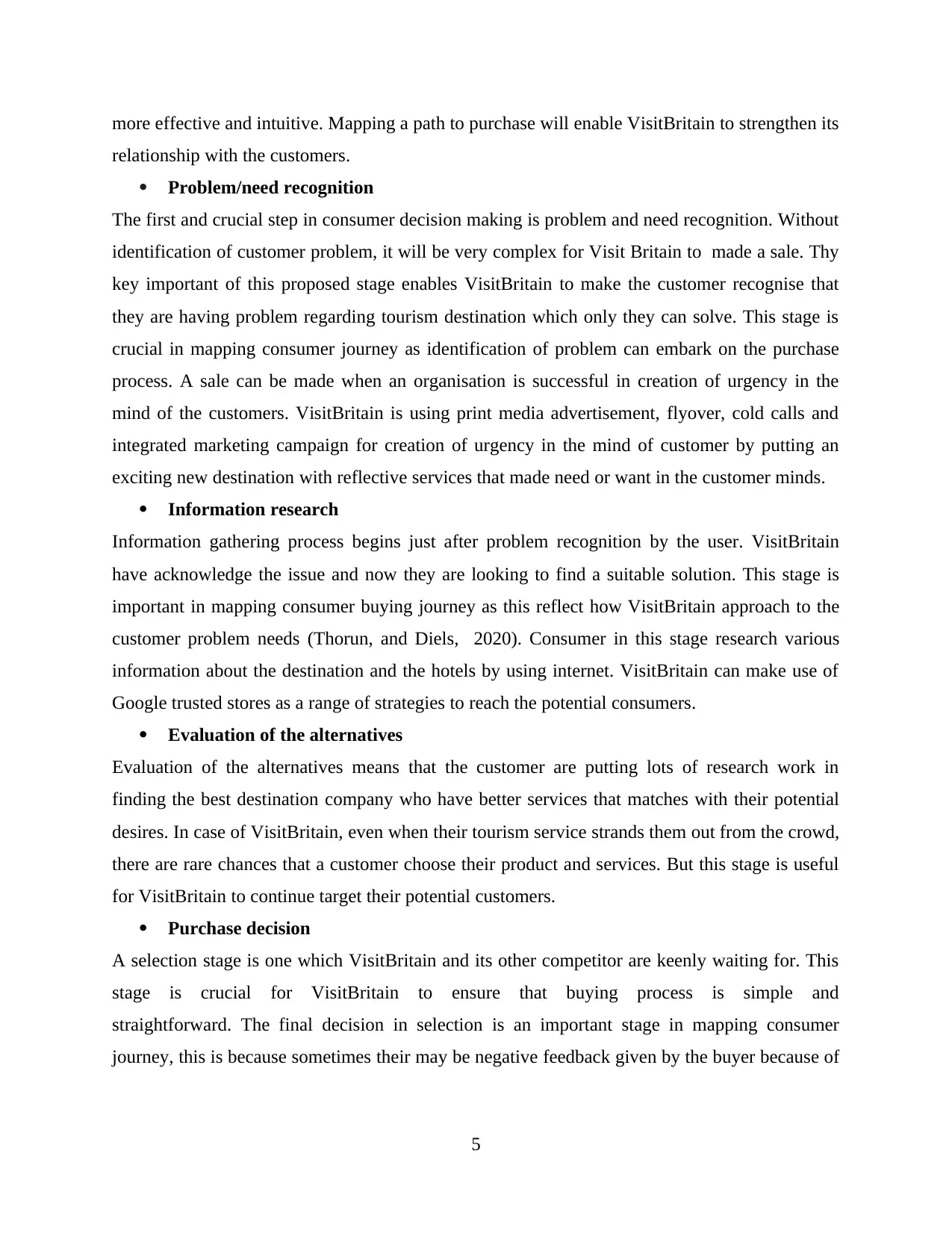
more effective and intuitive. Mapping a path to purchase will enable VisitBritain to strengthen its
relationship with the customers.
Problem/need recognition
The first and crucial step in consumer decision making is problem and need recognition. Without
identification of customer problem, it will be very complex for Visit Britain to made a sale. Thy
key important of this proposed stage enables VisitBritain to make the customer recognise that
they are having problem regarding tourism destination which only they can solve. This stage is
crucial in mapping consumer journey as identification of problem can embark on the purchase
process. A sale can be made when an organisation is successful in creation of urgency in the
mind of the customers. VisitBritain is using print media advertisement, flyover, cold calls and
integrated marketing campaign for creation of urgency in the mind of customer by putting an
exciting new destination with reflective services that made need or want in the customer minds.
Information research
Information gathering process begins just after problem recognition by the user. VisitBritain
have acknowledge the issue and now they are looking to find a suitable solution. This stage is
important in mapping consumer buying journey as this reflect how VisitBritain approach to the
customer problem needs (Thorun, and Diels, 2020). Consumer in this stage research various
information about the destination and the hotels by using internet. VisitBritain can make use of
Google trusted stores as a range of strategies to reach the potential consumers.
Evaluation of the alternatives
Evaluation of the alternatives means that the customer are putting lots of research work in
finding the best destination company who have better services that matches with their potential
desires. In case of VisitBritain, even when their tourism service strands them out from the crowd,
there are rare chances that a customer choose their product and services. But this stage is useful
for VisitBritain to continue target their potential customers.
Purchase decision
A selection stage is one which VisitBritain and its other competitor are keenly waiting for. This
stage is crucial for VisitBritain to ensure that buying process is simple and
straightforward. The final decision in selection is an important stage in mapping consumer
journey, this is because sometimes their may be negative feedback given by the buyer because of
5
relationship with the customers.
Problem/need recognition
The first and crucial step in consumer decision making is problem and need recognition. Without
identification of customer problem, it will be very complex for Visit Britain to made a sale. Thy
key important of this proposed stage enables VisitBritain to make the customer recognise that
they are having problem regarding tourism destination which only they can solve. This stage is
crucial in mapping consumer journey as identification of problem can embark on the purchase
process. A sale can be made when an organisation is successful in creation of urgency in the
mind of the customers. VisitBritain is using print media advertisement, flyover, cold calls and
integrated marketing campaign for creation of urgency in the mind of customer by putting an
exciting new destination with reflective services that made need or want in the customer minds.
Information research
Information gathering process begins just after problem recognition by the user. VisitBritain
have acknowledge the issue and now they are looking to find a suitable solution. This stage is
important in mapping consumer buying journey as this reflect how VisitBritain approach to the
customer problem needs (Thorun, and Diels, 2020). Consumer in this stage research various
information about the destination and the hotels by using internet. VisitBritain can make use of
Google trusted stores as a range of strategies to reach the potential consumers.
Evaluation of the alternatives
Evaluation of the alternatives means that the customer are putting lots of research work in
finding the best destination company who have better services that matches with their potential
desires. In case of VisitBritain, even when their tourism service strands them out from the crowd,
there are rare chances that a customer choose their product and services. But this stage is useful
for VisitBritain to continue target their potential customers.
Purchase decision
A selection stage is one which VisitBritain and its other competitor are keenly waiting for. This
stage is crucial for VisitBritain to ensure that buying process is simple and
straightforward. The final decision in selection is an important stage in mapping consumer
journey, this is because sometimes their may be negative feedback given by the buyer because of
5
Paraphrase This Document
Need a fresh take? Get an instant paraphrase of this document with our AI Paraphraser
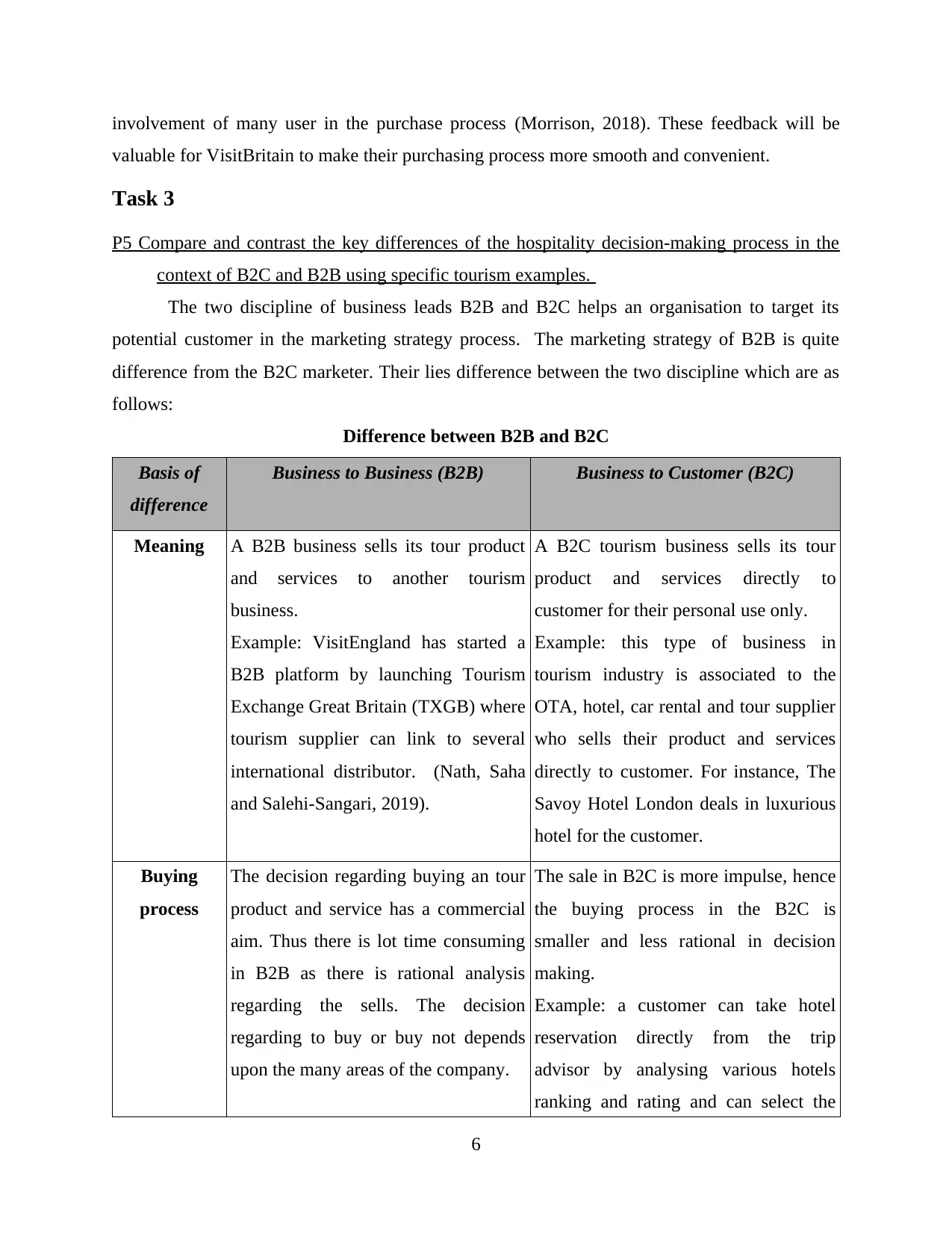
involvement of many user in the purchase process (Morrison, 2018). These feedback will be
valuable for VisitBritain to make their purchasing process more smooth and convenient.
Task 3
P5 Compare and contrast the key differences of the hospitality decision-making process in the
context of B2C and B2B using specific tourism examples.
The two discipline of business leads B2B and B2C helps an organisation to target its
potential customer in the marketing strategy process. The marketing strategy of B2B is quite
difference from the B2C marketer. Their lies difference between the two discipline which are as
follows:
Difference between B2B and B2C
Basis of
difference
Business to Business (B2B) Business to Customer (B2C)
Meaning A B2B business sells its tour product
and services to another tourism
business.
Example: VisitEngland has started a
B2B platform by launching Tourism
Exchange Great Britain (TXGB) where
tourism supplier can link to several
international distributor. (Nath, Saha
and Salehi-Sangari, 2019).
A B2C tourism business sells its tour
product and services directly to
customer for their personal use only.
Example: this type of business in
tourism industry is associated to the
OTA, hotel, car rental and tour supplier
who sells their product and services
directly to customer. For instance, The
Savoy Hotel London deals in luxurious
hotel for the customer.
Buying
process
The decision regarding buying an tour
product and service has a commercial
aim. Thus there is lot time consuming
in B2B as there is rational analysis
regarding the sells. The decision
regarding to buy or buy not depends
upon the many areas of the company.
The sale in B2C is more impulse, hence
the buying process in the B2C is
smaller and less rational in decision
making.
Example: a customer can take hotel
reservation directly from the trip
advisor by analysing various hotels
ranking and rating and can select the
6
valuable for VisitBritain to make their purchasing process more smooth and convenient.
Task 3
P5 Compare and contrast the key differences of the hospitality decision-making process in the
context of B2C and B2B using specific tourism examples.
The two discipline of business leads B2B and B2C helps an organisation to target its
potential customer in the marketing strategy process. The marketing strategy of B2B is quite
difference from the B2C marketer. Their lies difference between the two discipline which are as
follows:
Difference between B2B and B2C
Basis of
difference
Business to Business (B2B) Business to Customer (B2C)
Meaning A B2B business sells its tour product
and services to another tourism
business.
Example: VisitEngland has started a
B2B platform by launching Tourism
Exchange Great Britain (TXGB) where
tourism supplier can link to several
international distributor. (Nath, Saha
and Salehi-Sangari, 2019).
A B2C tourism business sells its tour
product and services directly to
customer for their personal use only.
Example: this type of business in
tourism industry is associated to the
OTA, hotel, car rental and tour supplier
who sells their product and services
directly to customer. For instance, The
Savoy Hotel London deals in luxurious
hotel for the customer.
Buying
process
The decision regarding buying an tour
product and service has a commercial
aim. Thus there is lot time consuming
in B2B as there is rational analysis
regarding the sells. The decision
regarding to buy or buy not depends
upon the many areas of the company.
The sale in B2C is more impulse, hence
the buying process in the B2C is
smaller and less rational in decision
making.
Example: a customer can take hotel
reservation directly from the trip
advisor by analysing various hotels
ranking and rating and can select the
6
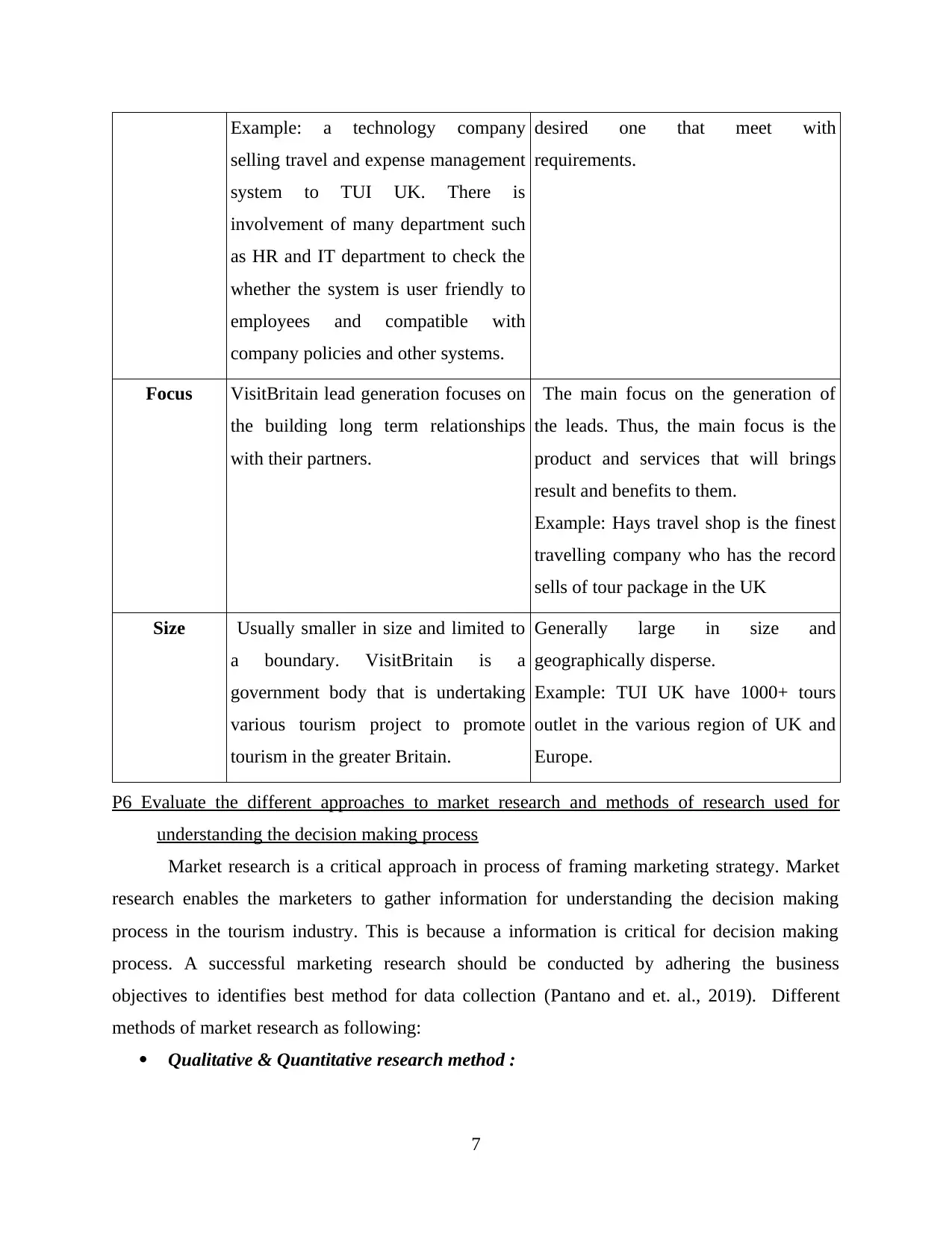
Example: a technology company
selling travel and expense management
system to TUI UK. There is
involvement of many department such
as HR and IT department to check the
whether the system is user friendly to
employees and compatible with
company policies and other systems.
desired one that meet with
requirements.
Focus VisitBritain lead generation focuses on
the building long term relationships
with their partners.
The main focus on the generation of
the leads. Thus, the main focus is the
product and services that will brings
result and benefits to them.
Example: Hays travel shop is the finest
travelling company who has the record
sells of tour package in the UK
Size Usually smaller in size and limited to
a boundary. VisitBritain is a
government body that is undertaking
various tourism project to promote
tourism in the greater Britain.
Generally large in size and
geographically disperse.
Example: TUI UK have 1000+ tours
outlet in the various region of UK and
Europe.
P6 Evaluate the different approaches to market research and methods of research used for
understanding the decision making process
Market research is a critical approach in process of framing marketing strategy. Market
research enables the marketers to gather information for understanding the decision making
process in the tourism industry. This is because a information is critical for decision making
process. A successful marketing research should be conducted by adhering the business
objectives to identifies best method for data collection (Pantano and et. al., 2019). Different
methods of market research as following:
Qualitative & Quantitative research method :
7
selling travel and expense management
system to TUI UK. There is
involvement of many department such
as HR and IT department to check the
whether the system is user friendly to
employees and compatible with
company policies and other systems.
desired one that meet with
requirements.
Focus VisitBritain lead generation focuses on
the building long term relationships
with their partners.
The main focus on the generation of
the leads. Thus, the main focus is the
product and services that will brings
result and benefits to them.
Example: Hays travel shop is the finest
travelling company who has the record
sells of tour package in the UK
Size Usually smaller in size and limited to
a boundary. VisitBritain is a
government body that is undertaking
various tourism project to promote
tourism in the greater Britain.
Generally large in size and
geographically disperse.
Example: TUI UK have 1000+ tours
outlet in the various region of UK and
Europe.
P6 Evaluate the different approaches to market research and methods of research used for
understanding the decision making process
Market research is a critical approach in process of framing marketing strategy. Market
research enables the marketers to gather information for understanding the decision making
process in the tourism industry. This is because a information is critical for decision making
process. A successful marketing research should be conducted by adhering the business
objectives to identifies best method for data collection (Pantano and et. al., 2019). Different
methods of market research as following:
Qualitative & Quantitative research method :
7
⊘ This is a preview!⊘
Do you want full access?
Subscribe today to unlock all pages.

Trusted by 1+ million students worldwide
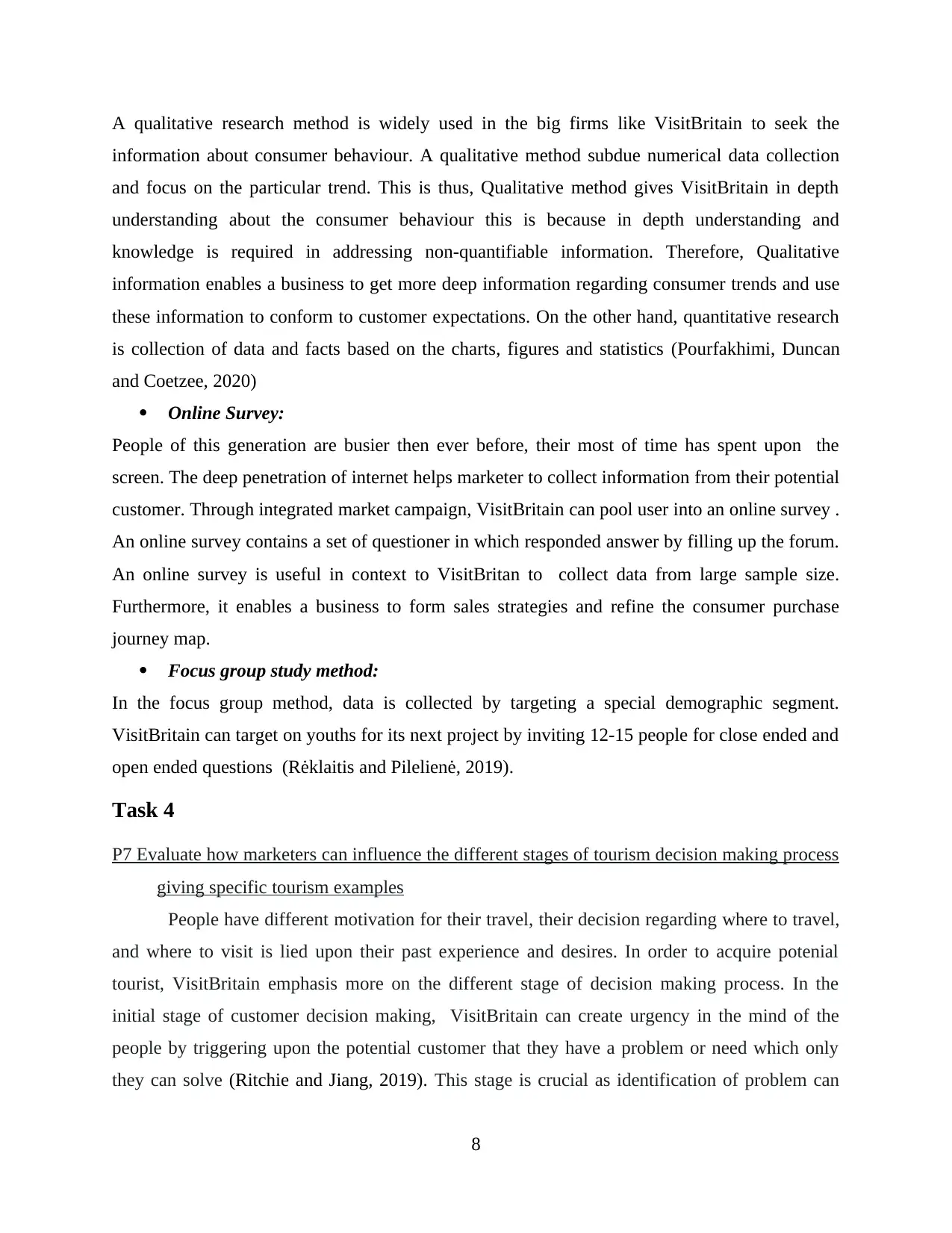
A qualitative research method is widely used in the big firms like VisitBritain to seek the
information about consumer behaviour. A qualitative method subdue numerical data collection
and focus on the particular trend. This is thus, Qualitative method gives VisitBritain in depth
understanding about the consumer behaviour this is because in depth understanding and
knowledge is required in addressing non-quantifiable information. Therefore, Qualitative
information enables a business to get more deep information regarding consumer trends and use
these information to conform to customer expectations. On the other hand, quantitative research
is collection of data and facts based on the charts, figures and statistics (Pourfakhimi, Duncan
and Coetzee, 2020)
Online Survey:
People of this generation are busier then ever before, their most of time has spent upon the
screen. The deep penetration of internet helps marketer to collect information from their potential
customer. Through integrated market campaign, VisitBritain can pool user into an online survey .
An online survey contains a set of questioner in which responded answer by filling up the forum.
An online survey is useful in context to VisitBritan to collect data from large sample size.
Furthermore, it enables a business to form sales strategies and refine the consumer purchase
journey map.
Focus group study method:
In the focus group method, data is collected by targeting a special demographic segment.
VisitBritain can target on youths for its next project by inviting 12-15 people for close ended and
open ended questions (Rėklaitis and Pilelienė, 2019).
Task 4
P7 Evaluate how marketers can influence the different stages of tourism decision making process
giving specific tourism examples
People have different motivation for their travel, their decision regarding where to travel,
and where to visit is lied upon their past experience and desires. In order to acquire potenial
tourist, VisitBritain emphasis more on the different stage of decision making process. In the
initial stage of customer decision making, VisitBritain can create urgency in the mind of the
people by triggering upon the potential customer that they have a problem or need which only
they can solve (Ritchie and Jiang, 2019). This stage is crucial as identification of problem can
8
information about consumer behaviour. A qualitative method subdue numerical data collection
and focus on the particular trend. This is thus, Qualitative method gives VisitBritain in depth
understanding about the consumer behaviour this is because in depth understanding and
knowledge is required in addressing non-quantifiable information. Therefore, Qualitative
information enables a business to get more deep information regarding consumer trends and use
these information to conform to customer expectations. On the other hand, quantitative research
is collection of data and facts based on the charts, figures and statistics (Pourfakhimi, Duncan
and Coetzee, 2020)
Online Survey:
People of this generation are busier then ever before, their most of time has spent upon the
screen. The deep penetration of internet helps marketer to collect information from their potential
customer. Through integrated market campaign, VisitBritain can pool user into an online survey .
An online survey contains a set of questioner in which responded answer by filling up the forum.
An online survey is useful in context to VisitBritan to collect data from large sample size.
Furthermore, it enables a business to form sales strategies and refine the consumer purchase
journey map.
Focus group study method:
In the focus group method, data is collected by targeting a special demographic segment.
VisitBritain can target on youths for its next project by inviting 12-15 people for close ended and
open ended questions (Rėklaitis and Pilelienė, 2019).
Task 4
P7 Evaluate how marketers can influence the different stages of tourism decision making process
giving specific tourism examples
People have different motivation for their travel, their decision regarding where to travel,
and where to visit is lied upon their past experience and desires. In order to acquire potenial
tourist, VisitBritain emphasis more on the different stage of decision making process. In the
initial stage of customer decision making, VisitBritain can create urgency in the mind of the
people by triggering upon the potential customer that they have a problem or need which only
they can solve (Ritchie and Jiang, 2019). This stage is crucial as identification of problem can
8
Paraphrase This Document
Need a fresh take? Get an instant paraphrase of this document with our AI Paraphraser
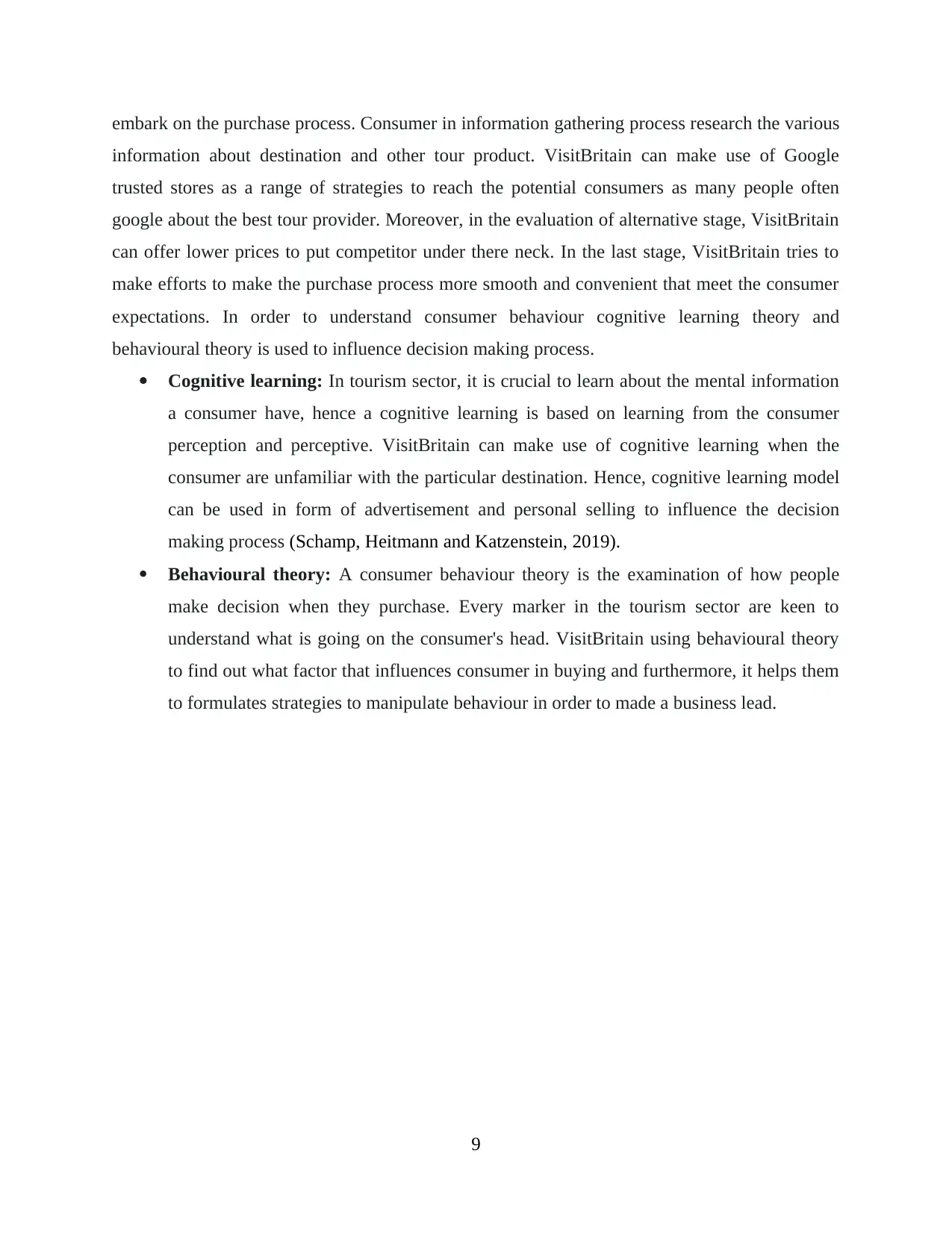
embark on the purchase process. Consumer in information gathering process research the various
information about destination and other tour product. VisitBritain can make use of Google
trusted stores as a range of strategies to reach the potential consumers as many people often
google about the best tour provider. Moreover, in the evaluation of alternative stage, VisitBritain
can offer lower prices to put competitor under there neck. In the last stage, VisitBritain tries to
make efforts to make the purchase process more smooth and convenient that meet the consumer
expectations. In order to understand consumer behaviour cognitive learning theory and
behavioural theory is used to influence decision making process.
Cognitive learning: In tourism sector, it is crucial to learn about the mental information
a consumer have, hence a cognitive learning is based on learning from the consumer
perception and perceptive. VisitBritain can make use of cognitive learning when the
consumer are unfamiliar with the particular destination. Hence, cognitive learning model
can be used in form of advertisement and personal selling to influence the decision
making process (Schamp, Heitmann and Katzenstein, 2019).
Behavioural theory: A consumer behaviour theory is the examination of how people
make decision when they purchase. Every marker in the tourism sector are keen to
understand what is going on the consumer's head. VisitBritain using behavioural theory
to find out what factor that influences consumer in buying and furthermore, it helps them
to formulates strategies to manipulate behaviour in order to made a business lead.
9
information about destination and other tour product. VisitBritain can make use of Google
trusted stores as a range of strategies to reach the potential consumers as many people often
google about the best tour provider. Moreover, in the evaluation of alternative stage, VisitBritain
can offer lower prices to put competitor under there neck. In the last stage, VisitBritain tries to
make efforts to make the purchase process more smooth and convenient that meet the consumer
expectations. In order to understand consumer behaviour cognitive learning theory and
behavioural theory is used to influence decision making process.
Cognitive learning: In tourism sector, it is crucial to learn about the mental information
a consumer have, hence a cognitive learning is based on learning from the consumer
perception and perceptive. VisitBritain can make use of cognitive learning when the
consumer are unfamiliar with the particular destination. Hence, cognitive learning model
can be used in form of advertisement and personal selling to influence the decision
making process (Schamp, Heitmann and Katzenstein, 2019).
Behavioural theory: A consumer behaviour theory is the examination of how people
make decision when they purchase. Every marker in the tourism sector are keen to
understand what is going on the consumer's head. VisitBritain using behavioural theory
to find out what factor that influences consumer in buying and furthermore, it helps them
to formulates strategies to manipulate behaviour in order to made a business lead.
9
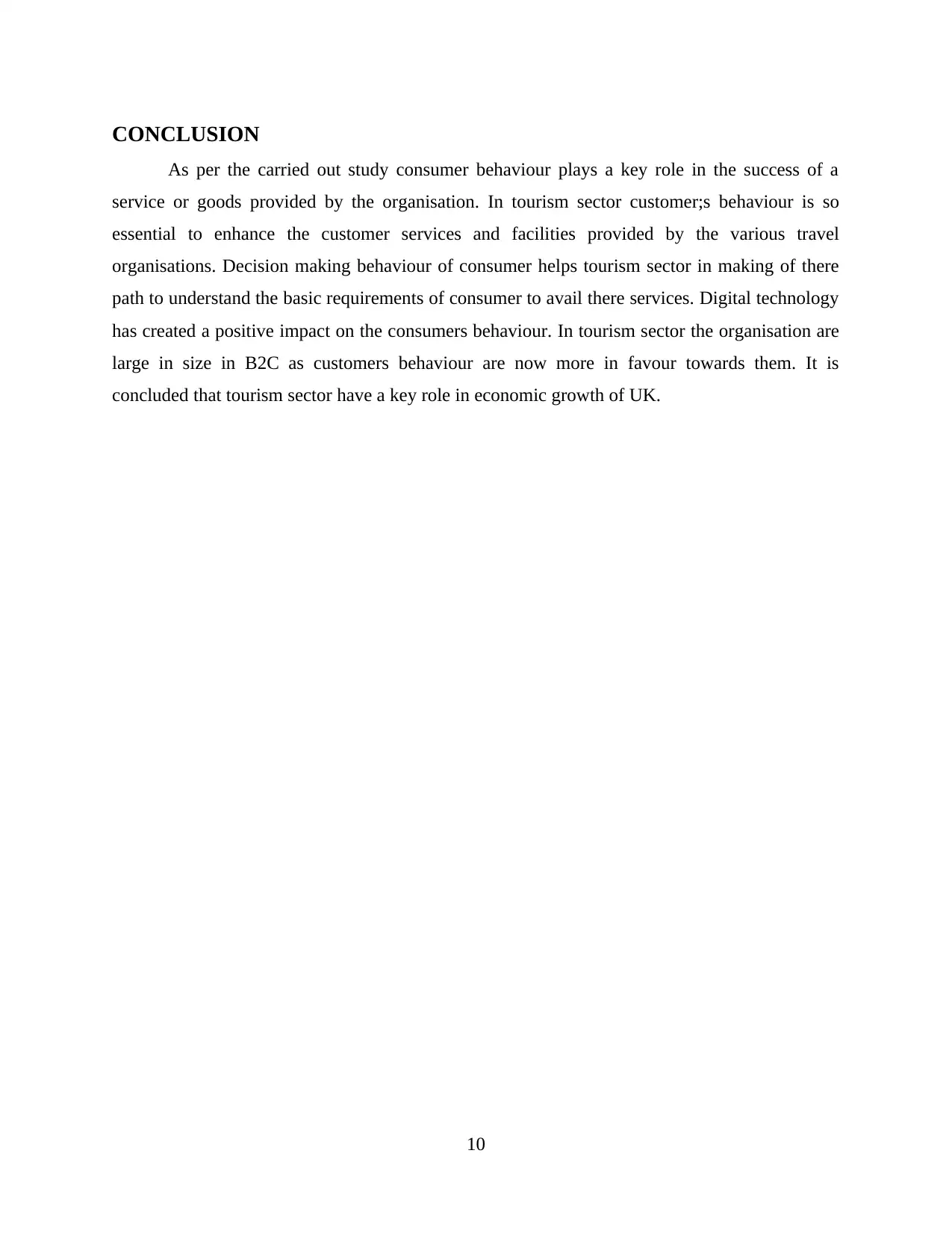
CONCLUSION
As per the carried out study consumer behaviour plays a key role in the success of a
service or goods provided by the organisation. In tourism sector customer;s behaviour is so
essential to enhance the customer services and facilities provided by the various travel
organisations. Decision making behaviour of consumer helps tourism sector in making of there
path to understand the basic requirements of consumer to avail there services. Digital technology
has created a positive impact on the consumers behaviour. In tourism sector the organisation are
large in size in B2C as customers behaviour are now more in favour towards them. It is
concluded that tourism sector have a key role in economic growth of UK.
10
As per the carried out study consumer behaviour plays a key role in the success of a
service or goods provided by the organisation. In tourism sector customer;s behaviour is so
essential to enhance the customer services and facilities provided by the various travel
organisations. Decision making behaviour of consumer helps tourism sector in making of there
path to understand the basic requirements of consumer to avail there services. Digital technology
has created a positive impact on the consumers behaviour. In tourism sector the organisation are
large in size in B2C as customers behaviour are now more in favour towards them. It is
concluded that tourism sector have a key role in economic growth of UK.
10
⊘ This is a preview!⊘
Do you want full access?
Subscribe today to unlock all pages.

Trusted by 1+ million students worldwide
1 out of 13
Related Documents
Your All-in-One AI-Powered Toolkit for Academic Success.
+13062052269
info@desklib.com
Available 24*7 on WhatsApp / Email
![[object Object]](/_next/static/media/star-bottom.7253800d.svg)
Unlock your academic potential
Copyright © 2020–2025 A2Z Services. All Rights Reserved. Developed and managed by ZUCOL.




